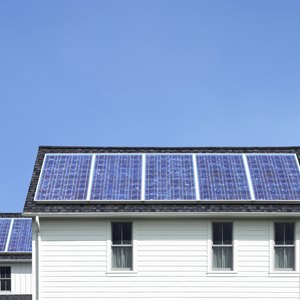
Year after year, the U.S. President and the legislative branch promise to overhaul the U.S. tax code. One initiative that gained the momentum needed to be passed into law was that which granted tax credits to those citizens who made qualified energy-efficient improvements to their homes. The Nonbusiness Energy Property Credit, for example, is available to homeowners who install solar panels or solar-powered water heaters, as per the Internal Revenue Service (IRS).
As another example, the IRS says that insulation material and systems which, by design, reduce heat loss or gain for your home, qualify for energy credits. The same is not true, however, for those materials that provide structural support or a finished surface for your home, such as siding. To qualify for a tax credit, the primary purpose of a material must be to reduce heat loss or gain.
Tax Credit Value of EE Improvement
The residential energy-efficient property tax credit is equal to a percentage of the cost of qualifying energy-efficient home improvement, says Consumer Affairs. According to the IRS, qualifying improvements include solar electric property, solar water heaters, geothermal heat pumps, small wind turbines, fuel cell property and, as of December 31, 2020, qualified biomass fuel property expenditures. The credit for alternative energy equipment is restricted to property placed in service before December 31, 2023.
The dollar value of the tax credit you can claim is determined in part by the year that the equipment is placed in service. According to the IRS, the applicable percentages are:
- If property was placed in service after December 31, 2016, but before January 1, 2020, the tax credit equals 30 percent of the improvement's cost.
- If property was placed in service after December 31, 2019, but before January 1, 2023, the tax credit equals 26 percent of the improvement's cost.
- If the property was placed in service after December 31, 2022, and before January 1, 2024, the tax credit equals 22 percent of the improvement's cost.
Benefit of the EE Improvement Tax Credit
As a taxpayer, you can subtract a tax credit from your tax liability, the latter of which is based on your taxable income. A tax deduction lowers your taxable income in that the taxable income is equal to your adjusted gross income minus allowable itemized or standard deductions. In contrast, a tax credit reduces your actual tax liability.
The nature of the tax credit determines its impact on your tax liability, meaning a tax credit results in a dollar-for-dollar decrease in your tax liability. For instance, as stated previously, an EE improvement tax credit may be applied in 2023 to an individual's tax liability because the taxpayer made a qualified improvement to her property. That tax credit may decrease your tax liability by as much as 22 percent of the improvement's cost.
What Is Taxable Income?
The IRS calculates your tax liability as a percentage of your taxable income by first subtracting nontaxable items from your total income and then subtracting credits and deductions from that subtotal.
Your income is equal to any income, regardless of source, that you receive before you reduce that figure by subtracting allowable deductions. This income includes that which you receive in the form of wages, salary and tips, and that which results from self-employment. Income also includes unearned income, such as dividends and interest earned on investments, royalties and gambling winnings as well as withdrawals from retirement accounts. For example, a taxpayer may earn $75,000 as wages plus $15,000 in unearned investment income for a gross income of $90,000.
Effect of EE Improvement Tax Credit on Tax Liability
The effect of the EE Improvement tax credit depends on multiple factors. Consider this example: For the 2021 tax year, a single-filer taxpayer has an income of $90,000. According to the Tax Foundation, she would falls in the 24 percent tax bracket and claim a standard deduction of $12,550. So, her taxable income equals $90,000 minus $12,550, or $77,450. This means a tax liability of $12,787.50.
She is eligible for an EE Improvement tax credit equal to the cost of solar panels of $14,820 multiplied by 22 percent, or $3,260, according to Consumer Affairs. Consequently, the taxpayer deducts the tax credit value of $3,260 from her tax liability of $12,787.50 to reduce it to $9,527.50.
For more information, see Form 5695 on the IRS.gov website.
References
Writer Bio
Billie Nordmeyer is an IT consultant of 25 years standing. As a senior technical consultant for SAP America and Deloitte Touche DRT Systems, a business analyst, senior staff, and independent consultant, Billie has worked across the retail, oil and gas, pharmaceutical, aeronautics and banking industries. Billie holds a BSBA accounting, MBA finance, MA international management as well as the Business Analyst and Software Project Management certificates from the Cockrell School of Engineering at the University of Texas at Austin.

